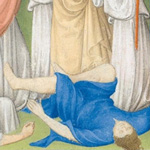 |
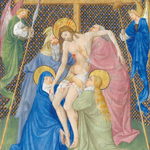 |
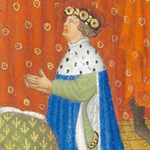 |
Above: Details of illuminations from Folio 73v, Folio 80r, and Folio 91r from the Belles Heures of Jean de France, duc de Berry, 1405–1408/9. Herman, Paul, and Jean de Limbourg (Franco-Netherlandish, active in France by 1399–1416). French; Made in Paris. Ink, tempera, and gold leaf on vellum; 9 3/8 x 6 5/8 in. (23.8 x 16.8 cm). The Metropolitan Museum of Art, New York, The Cloisters Collection, 1954 (54.1.1).
It is a jolt to move from the Penitential Psalms, which were among the earliest pages to be painted, to the Institution of the Great Litany, one of the added picture-book cycles created when the Limbourg brothers were more fully developed as artists. The Great Litany was one of the last sections to be completed, and the illuminations represent the artists near the pinnacle of their powers of expressive narration. Here, in a single, inserted bifolium—one sheet of parchment folded to make four pages—we see a great drama of life, death, and faith played out.
Detail of text from Folio 73r
The blue and red text, abbreviated from The Golden Legend, recounts the plague that decimated Rome in A.D. 590, and Pope Gregory’s response at that time. Preaching on the day of his consecration, and later leading a procession through the city, he instituted the form of prayer known as the Litany, invoking the aid of a succession of saints. Though the story depicted took place in Rome in the sixth century, the Limbourgs’ depiction of plague victims vividly demonstrates their familiarity with the appearance and drama of the pestilence in their own time.
Illumination from Folio 73r
The story opens on Folio 73r with Pope Gregory, inspired by the Dove of the Holy Spirit, preaching to a large group of laypeople and clergy. One group of cardinals comes through a doorway, while another groups bows their heads in study. In the foreground, the man in blue has just expired from the plague, while the man in green next to him appears to be sneezing—a sign that he will also die, according to the text on the following page (Folio 73v). At the right border, a youth and an old man recoiling at the horror of what they see seem to rush off to the right, beyond the border. The action moves from left to right, encouraging turning the page for the next part of the story. It continues from left to right on the next page, maintaining the momentum of the story with the Great Litany Procession and yet another plague victim.
Illumination from Folio 73v
From here, the reader’s eye is led to the facing page (Folio 74r), where the plague comes to an end with Archangel Michael sheathing his sword and the plague victims being buried.
Illumination from Folio 74r
Although this page seems conclusive, the reader would have been surprised by the scene on the next page—a coda to the story. The Procession of Flagellants (Folio 74v) shows an alternate response to the terror of plague and a different attempt at “imploring the protection of all the saints,” through self-chastisement. The dragon pennant carried aloft follows a raised cross bearing scourges and the crown of thorns: this shows a medieval custom for a three-day procession. On the first and second day, the cross follows the straw-filled dragon, representing the rule of the devil before the law, and under the law. Only on the third day does the dragon follow the cross, indicating the triumph of the cross and the rule of grace. Even if we didn’t know this historical detail, we would still marvel at the way beauty and brutality are combined in this extraordinary page.
Illumination from Folio 74v
While we are attracted to the half-nude male bodies, executed with a classical respect for the human form and luminous light, the action of flagellation with the visible stripes of blood on the backs of the participants is repellant. This is one of my favorite images in the whole manuscript, and I suppose it is in part because of its internal contradictions. The bodies are so solid, so fully realized in their movement and turning, and so compelling in their pale tonalities, while they are set against a patterned background derived from an older medieval tradition. Beauty and violence; space implied, space denied—attractive to a modern eye for abstraction and incongruity.
Following the Litany come the Hours of the Cross and the Holy Spirit, each introduced by one full-page illumination (Folio 80r and Folio 84r). Like the Hours of the Virgin, the texts of these sections provide prayers for the canonical hours and can be found in other books of hours. Like all the traditional sections in the Belles Heures, they are written in two columns in black ink.
Hours of the Cross
Illumination from Folio 80r
Some books of hours have a different scene for each of the Hours of the Cross. The Belles Heures saves the majority of these typical passion scenes for the later Hours of the Passion section and includes only one scene here, a Descent from the Cross (Folio 80r). It is depicted as a devotional scene, with Christ’s body displayed, spread out in an iconic stasis. Its timeless quality is reinforced by the flanking angels bearing the lance and sponge. The formality of the image is further emphasized by four additional mourning angels in quatrefoils in the corners of the border.
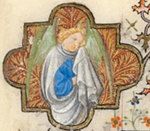 |
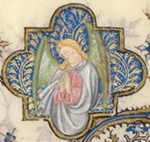 |
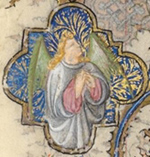 |
 |
Details of four quatrefoils from Folio 80r
Hours of the Holy Spirit
Illumination from Folio 84r
The illumination that marks the beginning of the Hours of Holy Spirit depicts the Pentecost, the moment described in The Acts of the Apostles when the Holy Spirit descends upon the apostles and the Virgin. The scene is imagined in a lovely churchlike structure with brilliant orange vaulting. If you look closely (see details below), you can see that this illumination was painted over a page ruled for text, and in a few cases, the Limbourg brothers used the ruled lines to guide elements of the scene. For example, the top horizontals of the architectural panels that flank the Virgin and mark out the side aisles are defined by one of the horizontal ruled lines.
Detail showing ruled lines in Folio 84r
Prayers
The following section, on Folios 88r through 93r, includes a group of prayers in French, the only text section of the manuscript to be written in the vernacular. (Although the calendar section is also technically in French, it is mostly a list.) It is in this section of the manuscript that Jean de Berry chooses to include his portrait and that of his wife the duchess.
Details from Folio 91r and Folio 91v
They are on opposite sides of the same folio, with the duke having a full-column illumination and the duchess a half-column, with the duchess looking at another quarter-page picture in the corner, a representation of the Trinity. The final almost full-column illustration in the section (Folio 93r) marks a prayer to the holy cross and shows two worshippers praying before an altar displaying the cross in a tall, vaulted church with a three-story elevation.
—Wendy A. Stein
Tags: flagellant, Great Litany, Hours of the Cross, Hours of the Holy Spirit, Pentecost, plague, Pope Gregory, procession, Rome, scourge


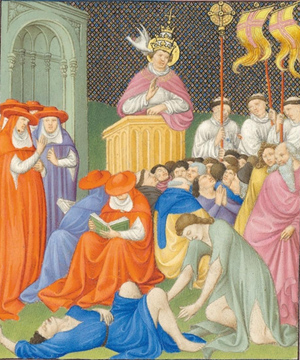

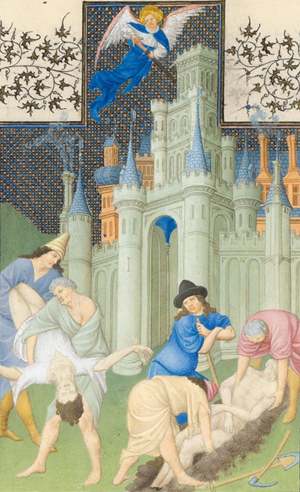
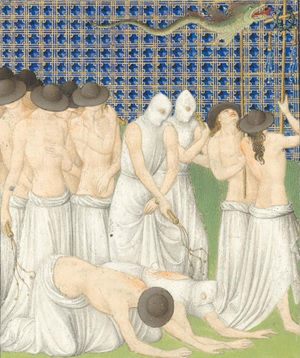
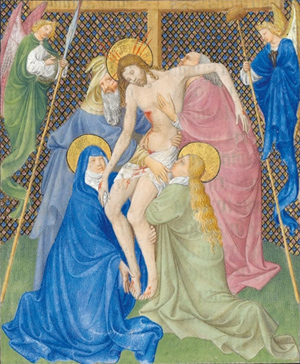

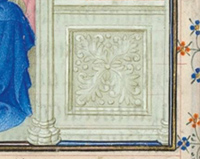


April 13, 2010 at 12:48 PM
I saw The Art of Illumination last week and felt it was one of the most beautiful exhibitions I have ever seen. Thank you.
April 14, 2010 at 10:45 AM
Dear Pamela,
Thank you for your kindness in expressing your appreciation. Tell your friends! and let me know if you have any questions.
Wendy